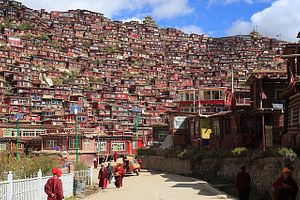Larung Gar, a small town located in the Tibetan Autonomous Prefecture, in Sichuan province, China, is famous for its world’s largest Tibetan Buddhist Monastery. However, the town has been caught in contention since 2016.
U.K.-based journalist Steve Shaw’s recent feature here in The Diplomat once again explained one side of the contention: he interviewed one traveler to Larung Gar and used this sole first-hand evidence to demonstrate that the Chinese government has been “demolishing homes” and evicting thousands people from the monastery. The following article is not to counter-argue with what Shaw contends in his feature, but to present the other side of the story — the Chinese government’s side — so that the readers could have a fuller picture of what might be happening in Larung Gar.
According to the local government’s official statement issued in June 2016, the local government never aimed to “demolish” the monastery. On the contrary, the local government had made a detailed plan to renovate the small town, in order to make it more clean, orderly, safe, and beautiful.
Then the statement elaborated on the monastery’s current problems:
- The monastery was severely overcrowded. The living area of the monastery looked like a maze so that people could hardly tell what direction they were going in. Many old and small wooden shelters, built by newcomers without proper design, could be serious fire hazards. For example, in January 2014, a fire resulted in multiple houses burnt, several monks hurt, and a total of 230 million RMB in damage.
- The monastery lacked fundamental infrastructure such as electricity, tap water, and even sewage systems; let alone TV or WiFi signals. Without a sewage system, local people’s excrement mixed with other trash smells terribly, especially in summer. The situation might trigger an epidemic as well.
- The monastery was an open institution where anyone could enter and stay without an ID check. The monastery had suffered from theft, with many visitors reported belongings being stolen.
Thus, the local government vowed to renovate the small town by building fire emergency routes and roads for tourists; supplying centralized water system; providing safe electricity; and adding waste disposal and other infrastructure.
As shown in Shaw’s article, the small town, located at an elevation of over 13,000 feet (3,962 meters), hosts somewhere between 10,000 and 40,000 residents. If what the local government said was true, the renovation seemed quite reasonable and necessary. And some demolishing was inevitable during the process.
So why are there still so many complaints and suspicion about the seemingly goodwill renovating plan?
The main problem might be the government’s lack of transparency in the plan designing and in the following implementation.
As Shaw said in his feature, even Free Tibet does not “entirely dismiss the notion that Larung Gar may have become overcrowded.” What Free Tibet criticized is the way the Chinese government dealt with the problem. If the local government was not lying about its true purpose and felt confident about their good-intended decision, then why don’t they allow foreigners — foreign journalists in particular — to visit the town and see it with their own eyes?
The lack of information and transparency is always a dark cloud hanging over the Chinese government’s way of governing, not only in this small town, but in the country as a whole.

































